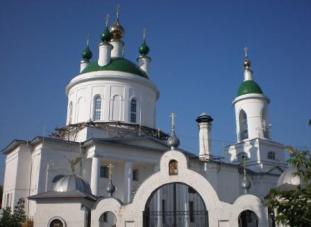

Location: Ulitsa Kolcova 19A
The Church of Saint Elijah the Prophet (also known as the Ilyinskaya Church or Church of Elijah the Prophet) is an active Russian Orthodox temple located in the city of Ivanovo, Ivanovo Oblast, Russia, at ul. Kol'tsova, 19A. It serves as a parish church under the Ivanovo-Voznesensk Diocese and is recognized as a cultural heritage site of regional significance in Russia (object number 3700001408). Constructed between 1838 and 1841, it exemplifies late classicism architecture and reflects the industrial and mercantile history of Ivanovo, a city renowned for its 19th-century textile boom. The church was founded by prominent local merchants and has endured periods of prosperity, closure under Soviet rule, and restoration in the post-Soviet era.
The church's origins are closely linked to Ivanovo's development as a
textile hub. In the late 18th century, calico printing emerged as the
dominant industry in the region. Following the devastation of Moscow's
industries during Napoleon's 1812 invasion, Ivanovo became Russia's
calico production center. Key figure Alexander Alekseevich Lepetov, a
wealthy merchant from a peasant background, played a pivotal role. He
traded in calico and cotton yarn, acquiring land from landowner E. I.
Barsukova in the village of Vorobyevo. By the 1830s, this area evolved
into Vorobyovskaya Sloboda with growing factories and population.
In
1838, Lepetov funded the church's construction on land donated by
merchant Ivan Diomidovich Kiselev. Residents soon petitioned Vladimir
Archbishop Parfeniy to rename the sloboda "Ilyinskaya" in honor of the
church. Stonework was completed in 1841, and the temple was consecrated
in 1842—coinciding with the feast of the Kazan Icon of the Mother of
God. A precious list (copy) of this icon, adorned with gems, was brought
for the occasion.
The church quickly became central to the community.
A fence, almshouse, and clergy houses were added. In 1893, Lepetov's
grandson, manufacturer A. I. Garelin, financed an internal
reconstruction designed by Moscow architect A. S. Kaminski. This unified
the summer and winter sections into one space and installed new
iconostases in the side chapels.
Soviet-era repression struck in 1935
when local authorities closed the church, removing its crosses and
repurposing it as a regional archive. For over 50 years, it
deteriorated: frescoes crumbled, walls molded, and vaults blackened from
soot. It was returned to believers in 1989 and to the diocese in 1990.
Archbishop Ambrosiy appointed Hieromonk Nikandr (Shamov) to lead
restoration. The first Divine Liturgy occurred on January 7, 1990
(Christmas), in the basement. The main altar's first service was on July
21, 1990, again on the Kazan Icon feast—echoing the 1842 consecration.
Today, the church hosts regular services, community events, and
educational programs, as noted on its official website
(prorok-ilia.cerkov.ru). It symbolizes resilience, blending spiritual
heritage with Ivanovo's industrial past.
Designed likely by Vladimir gubernia architect Evgraf Yakovlevich
Petrov, the church embodies late classicism, a style popular in
19th-century Russian ecclesiastical architecture for its symmetry,
grandeur, and classical motifs inspired by antiquity.
Exterior
Structure: The central volume is a cubic base topped by a cylindrical
drum supporting a five-domed roof, symbolizing Christ and the four
evangelists. The domes are modest yet elegant, with the central one
slightly larger. From the west, a tall bell tower adjoins, serving as a
vertical accent. Northern and southern facades feature four-column
porticos with pediments, adding neoclassical flair and creating shaded
entrances. The overall form creates a balanced, imposing silhouette that
dominated the sloboda's skyline.
Materials and Layout: Built
primarily of brick and stone, the church includes a refectory and side
chapels. A surrounding fence, added post-construction, encloses the
grounds, enhancing its role as a community focal point.
This
design reflects the era's shift toward more restrained, empire-style
influences while maintaining Orthodox traditions like multi-domed roofs.
Interior Features
The interior was significantly updated in 1893,
merging divided sections into a unified, expansive space for larger
congregations.
Iconostases and Altars: The main altar honors
Elijah the Prophet. Side chapels are dedicated to the Nativity of the
Theotokos and the Forty Martyrs of Sebaste, with surviving 1893
iconostases—multi-tiered wooden screens adorned with icons, carvings,
and gilding.
Frescoes and Paintings: Wall paintings, executed by
renowned Palekh artists the Belousov brothers (who also restored
frescoes in Moscow Kremlin's Faceted Chamber), depict biblical scenes
with vivid colors and expressive figures. Though damaged during the
archive period, restorations have revived their medieval-inspired
artistry, blending Byzantine influences with Russian folk elements.
Basement and Additional Spaces: The basement houses a baptismal church
consecrated to Saint John of Kronstadt, used for baptisms and smaller
services.
The interior evokes a sense of sacred continuity, with
relics like the Kazan Icon copy adding spiritual depth.
As a tentative cultural heritage site, the church preserves Ivanovo's
mercantile legacy amid rapid industrialization. It stands as one of the
few surviving 19th-century temples in a city where many were destroyed
under Soviet rule. Comparable to other Ivanovo churches like the
Transfiguration Cathedral or Vvedensky Church, it highlights regional
architectural evolution.
Visitors can attend services (daily, with
major feasts on July 20 for Elijah and July 21 for Kazan Icon). The site
is open to the public; modest dress is required. Its location in central
Ivanovo makes it accessible, with coordinates approximately
56°59'09.81"N, 40°56'59.33"E. For updates, check the parish website.
This description draws from historical records and architectural
analyses, providing a comprehensive view of a landmark that bridges
faith, industry, and resilience in Russian history.